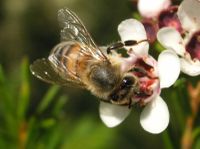Honey Bees, Blue Tits and Canaries

“If the bee disappeared off the surface of the globe, then man would only have four years of life left.”
–Albert Einstein (German-born American Physicist and, in 1921, Winner of the Nobel Prize in Physics, 1879-1955)
Anyone interested in Integrated Medicine should also be interested in trends that may have a major impact on our health and our potential to grow.
Over the last year the sparrow population of England has been declining, and now there is something new. In recent weeks there have been reports from bird watchers in Southern England that some species of birds have suddenly started become obese. The birds most affected seem to be blue tits. There is no suggestion about why it is happening, or what they are eating. Or whether something else in the environment is changing and causing the problem.
Second, British Government inspectors are investigating reports of unusually high numbers of honeybee deaths. Beekeepers all over Southern England are reporting that their hives have been decimated. This is a serious matter. Not just to the bees, but because bees pollinate fruit trees and other crops, the consequences for British farmers of a collapse in honey bee numbers could be devastating. The total contribution of bees to the British economy has been estimated at somewhere around 2 billion dollars.
No one yet understands the cause of these widespread honey bee colony deaths, and it is not just in the England: unexplained, severe colony losses with bees failing to return from their searches for pollen and nectar in Poland, Greece, Italy, Spain and Portugal.
But here in the United States the situation is even worse: Beekeepers in 25 US states have lost 50 to 90 per cent of their colonies to a mystery condition being called Colony Collapse Disorder (CCD) – in which bees suddenly abandon their hives and disappear to die. It is having a major effect on the mobile apiaries (Bee farms) that are transported across the US to
pollinate large-scale crops, such as oranges in Florida or almonds in
California. Some have lost up to 90 per cent of their bees.
The cause of CCD is unknown, but some of the suspects include pesticides, malnutrition, antibiotics, mites and increased solar radiation due to ozone thinning. There has also been a theory that it might have something to do with all those towers that support the cell phone network, or the introduction of genetically modified crops.
In the 1990s, honeybee populations were badly affected by the varroa mite – a parasite that makes colonies more vulnerable to viruses. Some experts believe the recent deaths could be caused by the parasite becoming resistant to drugs used against it.
Like most things in nature, animal populations go through regular cycles: there is a sophisticated mathematics that can be used to describe fluctuations in populations. But when we see several odd things at once, that don’t fit the mathematical models, it is time to ask the question whether the obese blue tits and the disappearance of sparrows and bees are a harbinger of further changes in our environment.
Are the bees and blue tits the “Canaries in the Coal Mine”?






